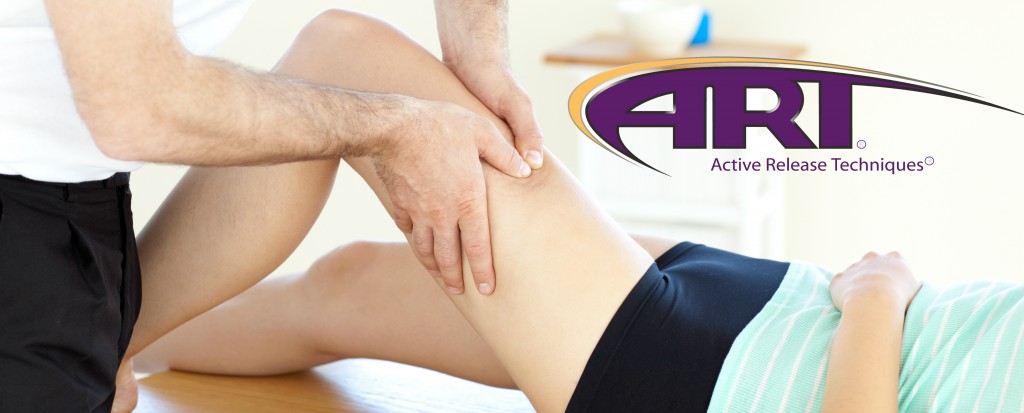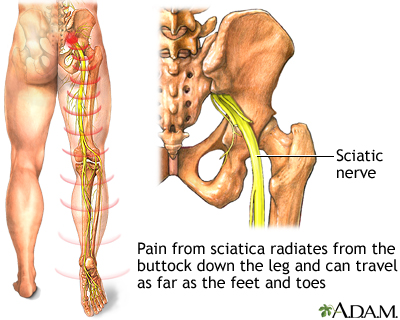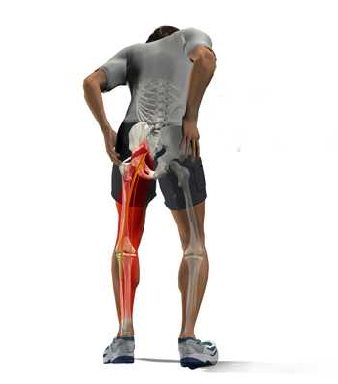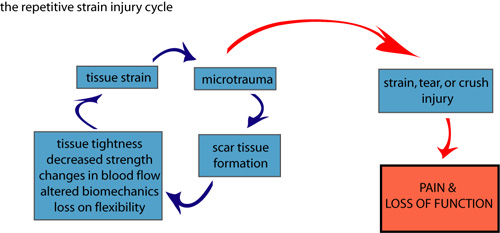Resolving Leg Pain with Active Release Techniques (ART)
Leg pain – often diagnosed as Sciatica – can be a painful and debilitating problem that commonly interferes with walking, standing, sitting, and sleeping. In some cases it is difficult to find any comfortable position at all. Along with pain, symptoms such as throbbing, numbness, weakness, and “pins-and-needles” can also be present. Adding to the frustration of these symptoms, this type of leg pain is often initiated by a seemingly routine task, or in many cases has no clear cause at all. To make matters even worse, these leg conditions are slow to respond to traditional types of care, often creating further disappointment and aggravation.
Now for the good news, a new treatment technique known as Active Release Techniques® (ART®) is proving to be a very effective method to treat many common leg problems and is helping to get those who suffer from Sciatica symptoms back doing their favourite activities. But before we talk about how ART® works so effectively, first you need to understand how Sciatica symptoms develop in the first place.
What is Sciatica?
As the lower 5 nerve roots exit the spinal column they join together to form the Sciatica nerve. Sciatica refers to pain that develops as a result of compression or irritation of this nerve. As the nerve roots come together to form the Sciatic nerve – which occurs close to the spine in the upper region of the hip – the Sciatica nerve travels down the back of the leg al the way to the foot. As the nerve travels down along the back of the hip, thigh, knee, and calf it must pass between – and in some cases through – the muscles of these regions. As long as the muscles are loose and flexible, and the nerve is able to freely glide along these muscles, the nerve remains healthy. However, if the nerve becomes compressed or irritated at any point along its path from the spine to the foot, Sciatica pain can develop.
It is important to realize that Sciatica refers to a group of symptoms that occur as a result of injury and irritation to the Sciatic nerve. It is not a specific diagnosis and does not indicate what is actually causing the nerve irritation. Actually, there are many distinct conditions that can cause the Sciatic nerve to become injured. One common misconception is that Sciatica always results from a Disc Herniation of the lower back. Although Disc Herniations often result in Sciatica symptoms, they are actually one of the less common causes of Sciatica. In fact, it is much more common for Sciatica symptoms to develop as a result of problems in the muscles of the hip and leg. As the Sciatic nerve travels between the muscles of the hip, thigh, and calf, if any of these muscles become excessively tight or restricted they can compress the nerve and prevent the nerve from gliding freely between the muscles. As this happens the nerve will become irritated and symptoms of Sciatica will develop.
How Does Injury Occur?
The hip, knee, and ankle are joints that require a complex system of muscles to ensure proper movement and to protect each area from injury. Through a variety of causes such as excessive or repetitive use with certain sports or occupations, muscle imbalances, prolonged sitting, previous injury, or lack of stretching and exercise, it is not uncommon for small amounts of strain and imbalances to develop with the muscles of the hip, knee, and ankle.
Over time this strain can develop into what is know as micro-trauma. Simply stated, micro-trauma is very small scale damage that occurs in the muscles, tendons, joint capsules, and ligaments in response to small levels of strain. Initially this micro-trauma is not painful, but may be perceived as a mild ache or tightness in the muscles. Although only small, this damage still needs to be repaired. The body responds to micro-trauma in a predictable way – by laying down small amounts of scar tissue to repair the area. Unfortunately, over time this scar tissue will build-up and accumulate into what we call adhesions. As adhesions form they will start to affect the normal health and function of the muscles and related joints, often leading to pain, tightness, stiffness, restricted joint motion, and diminished blood flow.
In addition to causing problems in the muscles and joints themselves, the accumulation of adhesions can also cause considerable strain and irritation to the Sciatic nerve as they will restrict the normal sliding of the nerve between the muscles. Recall that the Sciatic nerve passes between and through the various muscles of the hip and leg and to remain healthy must be able to freely slide between these muscles. As adhesions develop they will cause the muscles to become tight and restricted, which will in turn compress the Sciatic nerve trapping it between the muscles and muscle layers. In addition to becoming trapped by the tight muscles, as adhesions develop along the path of the Sciatic nerve the nerve itself can actually become “stuck” to the surrounding muscles. In either situation the ability of the nerve to slide is drastically compromised. When this happens the nerve is forced to stretch instead of slide, which causes the nerve to become irritated.
As the process continues further strain is placed on the nerve and surrounding muscles, which in turn leads to even more micro-trauma. Essentially a repetitive strain injury cycle is set-up causing continued adhesion formation and progressive nerve irritation – and more severe nerve injury if the condition is allowed to continue.
Common Sites of Entrapment and the “Double Crush” Syndrome
It is possible for the Sciatic nerve to become trapped and irritated at any point along its path between the spine and the foot; however, there are certain areas where the nerve is more prone to entrapment. One of the most common areas of entrapment is at the Piriformis muscle, which is located deep in the back of the hip. The Sciatic nerve travels directly underneath (and in some cases through the middle) of this muscle, and it is very common for this muscle to become tight and to develop adhesions. When this happens it can entrap and irritate the Sciatic nerve, and result in Sciatica symptoms. In this case, the diagnosis would be Piriformis Syndrome.
As the Sciatic nerve travels further down the leg, it is also very common for entrapment to occur at the Hamstring muscle, between the Hamstring and Adductor muscles on the inner thigh, at the top of the calf as the nerve passes through the Soleus muscle, and finally as it passes under the ligaments of the on the side of the ankle. The interesting fact is that when the nerve becomes entrapped at any of these sites, it can cause pain and other symptoms to be felt along the entire nerve, not just the area where the nerve is entrapped. Making matters more complicated, it has also been found that as the nerve is irritated and entrapped at one site, it becomes more prone to irritation at other sites as well. This leads to what is referred to as a “Double Crush” Syndrome as the Sciatica symptoms are actually being generated at 2 different entrapment sites. Obviously, when this occurs both sites must be addressed for complete resolution to be reached.
How Can These Nerve Entrapments Be Fixed?
The Traditional Approach…
In an attempt to relieve Sciatic pain, a variety of treatment methods are used, either on their own, or in combination with other methods. Some of the more common approaches include muscle relaxants, anti-inflammatory medications, rest, heat, ice, ultrasound, traction, massage, acupuncture, joint manipulation, and stretching and strengthening exercises. Unfortunately, most of these traditional techniques generally require a long period of time before they provide any significant relief, and in many cases provide only temporary relief from symptoms instead of fixing the underlying cause of the problem.
The main reason that these approaches are often ineffective is that they fail to address the underlying muscle dysfunction and scar tissue adhesions that develop within the muscles and surrounding soft tissues. It is these adhesions that are causing the muscles to become tight and restricted, and are entrapping the nerve and preventing the normal sliding of the nerve between the muscles.
Passive approaches such as muscle relaxants, anti-inflammatory medications, rest, ice, acupuncture, and ultrasound, all focus on symptomatic relief and do nothing to address the muscle restrictions and adhesion formation. More active approaches such as joint manipulation, stretching and exercises are often needed for complete rehabilitation of the condition and to restore full strength and function of the muscles, however, they themselves do not treat the underlying adhesions. In fact, without first addressing the scar tissue adhesions, stretches and exercises are often less effective and much slower to produce relief or recovery from Sciatic pain.
Active Release Techniques® Our Approach: ART® – A Better Solution
ART stands for Active Release Technique. It is a new and highly successful hands-on treatment method to address problems in the soft tissues of the body, including the muscles, ligaments, fascia, and nerves. ART* treatment is highly successful in dealing with injuries because it is specifically designed to locate and treat scar tissue adhesions that accumulate in the muscles and surrounding soft tissues. By locating and treating the soft-tissue adhesions with ART*, it allows the practitioner to, 1) break-up restrictive adhesions, 2) reinstate normal tissue flexibility and movement, and 3) more completely restore flexibility, balance, and stability to the injured area and to the entire kinetic chain.

You can think of an ART* treatment as a type of active massage. The practitioner will first shorten the muscle, tendon, or ligament, and then apply a very specific pressure with their hands as you actively stretch and lengthen the tissues. As the tissue lengthens the practitioner is able to assess the texture and tension of the muscle to determine if the tissue is healthy or contains scar tissue that needs further treatment. When scar tissue adhesions are felt the amount and direction of tension can be modified to treat the problematic area. In this sense, each treatment is also an assessment of the health of the area as we are able to feel specifically where the problem is occurring.
An additional benefit of ART is it allows us to further assess and correct problems not only at the site of pain itself, but also in other areas of the kinetic chain, which are associated with movement compensations and are often contributing factors to the problem. This ensures that all the soft tissues that have become dysfunctional and are contributing to the specific injury are addressed, even if they have not yet all developed pain. One of the best things about ART is how fast it can get results. In our experience, the majority of injuries respond very well to ART* treatment, especially when combined with the appropriate home stretching and strengthening exercises. Although each case is unique and there are several factors that will determine the length of time required to fully resolve each condition, we usually find a significant improvement can be gained in just 4 – 6 treatments. These results are the main reason that many elite athletes and professional sports teams have ART practitioners on staff, and why ART is an integral part of the Iron man triathlon series. To book an appointment to see if ART will be able to help with your related injury, simply call our office at 613.237.3306 or fax 613.237.3100




